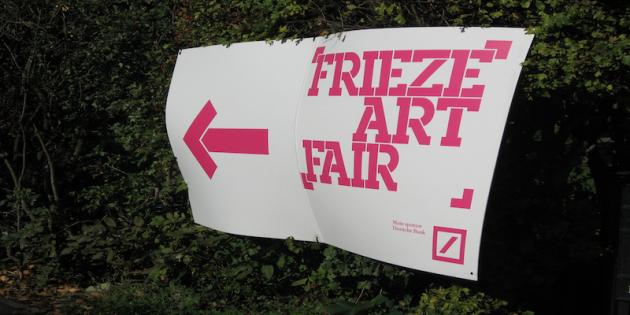Each October Regent’s Park is transformed into a cultural epicentre where the best of the international art world comes together to celebrate being the best. The entire city of London seems to come alive during Frieze week, even those not directly associated with the fair. Love it or loath it, Frieze is not to be missed, but it is also worthwhile to explore beyond the main pavilion and beyond Regent’s Park.
Frieze is a time when everything is big – big names, big statements, big crowds, big everything merge. Perhaps one of the most memorable stunts (or artwork?) of last year’s fair was Christian Jankowski’s high-end yacht for sale. Commenting on art and money in the most appropriate of venues, the yacht as a yacht was selling for €500,000, but the yacht as an art object with the artist’s name added €125,000 to the price tag. No one took the bait, but wild schemes draw attention and make Frieze what it is. Sponsored by Deutsche Bank and in an architecturally designed tent by Carmody Groarke, Frieze is a spectacle.
Frieze is about ‘aesthetics’ but it is also about money. Of course the vast majority of visitors to the fair do not have the means to purchase the works on offer, but the real purpose has, always been, and always will be buying and selling art. 2011 saw tens of thousands enter the doors and 2012 promises the same. 175 of the world’s leading contemporary galleries have snagged a coveted spot at the fair and include some familiar faces such as Gagosian, Hauser & Wirth, Alison Jacques, Lisson, Victoria Miro, Sprüth Magers, and White Cube. While London galleries will have a strong presence, galleries from Europe, Asia, and North America will also exhibit.
In my opinion, the most interesting part of the fair is Frame, the portion devoted to young galleries exhibited single-artist curated exhibitions. While these 21 galleries have not the prestige associated with the galleries listed above, the lesser-known does not imply less skill or less creativity. While many galleries include as many of their represented artists as possible in their allotted space, the Frame galleries are able to create thoughtful exhibitions more reminiscent of a typical gallery display than an open showroom.
The focus of Frieze is on the contemporary, but on the other side of the park, Frieze Masters highlights art from throughout history: ancient to modern. Over 90 galleries will take part in this fair, which aims to link the old and the new. There is some crossover with a number of galleries exhibiting at both fairs, but Frieze Masters gives the opportunity for galleries to demonstrate the lasting relevance of great art from the past. Frieze masters intends to set the standard of what a London art fair should aspire to. It aims to raise the stakes and bring London in line with Maastricht and Art Basel.
On the walk from the main fair to Frieze Masters (each with a hefty admission charge), the sculpture park is an accessible aspect of the fair – it’s free! The sculptures included this year have been selected by Clare Lilley, the Director of Programme at the Yorkshire Sculpture Park. The mix of established and emerging sculptors includes: Hemali Bhuta, Adip Dutta, Sam Falls, Hans Josephsohn, Alan Kane and Simon Periton, Yayoi Kusama, Sean Landers, Michael Landy, Peter Liversidge, Andreas Lolis, Jean-Luc Moulene, David Nash, Damian Ortega, Anri Sala, Thomas Scheibitz, William Turnbull, and Maria Zahle. After the crowds and confusion of the main tent, a stroll through the sculpture park allows some relaxation as well as interesting works of art.
During what has become known as “Frieze Week” it’s important not to limit oneself to just the ‘main attraction.’ Since the inception of the fair in 2003, a number of smaller satellite fairs have emerged to piggyback on the increased publicity and attendance Frieze provides. Just a hop, skip, and a jump from Regents Park is Ambika P3, host to Sunday Fair. The gallery-led venture is free to the public and encourages a more relaxed environment. While small in comparison to Freize, 2011 had over 6,000 visitors throughout the four days demonstrating its popularity. Another interesting alternative is the Moniker Art Fair at the Village Underground. The idea of Moniker is creating a platform for artists to be experimental, and this year’s installation art theme will see many artists pushing their boundaries in a non-traditional fair setting. At Frieze, most works on display will be in traditional media, so Moving Image was created to be a contemporary video art fair. Located on the South Bank by Tate Modern, Moving Image encourages a new exhibition experience and brings visitors further south. Last year, Sluice Art Fair was created as another satellite fair with a focus on not-for-profit gallery and artist spaces. This year, however, later in October, the organizers will be hosting a Sluice art auction as a break from the traditional fair form. Multiplied will also be returning to Christie’s South Kensington with another offering of limited edition prints and multiples.
In addition to everything going on in Regent’s Park, many galleries have set up top-notch exhibitions, after a somewhat slow summer. Highly influential dealers, artists, gallerists, and enthusiasts from around the world are coming to London in just a couple weeks – it’s time to get out and explore the best the city has to offer.
Words: Emily Sack © ArtLyst 2012

